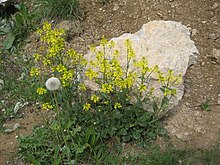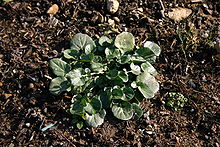Winter cress
| Winter cress | ||||||||||||
|---|---|---|---|---|---|---|---|---|---|---|---|---|

Winter cress ( Barbarea vulgaris ), illustration |
||||||||||||
| Systematics | ||||||||||||
|
||||||||||||
| Scientific name | ||||||||||||
| Barbarea vulgaris | ||||||||||||
| WTAiton |
The winter cress ( Barbarea vulgaris ), also known as Barbara's herb, more precisely called common Barbara's herb or true Barbara's herb, is a species of the cruciferous family (Brassicaceae). The winter cress can be used as a salad or a vegetable and it is said to have a blood-purifying effect in naturopathy.
features
The biennial plant reaches heights of 30 to 90 cm. It forms its leaves in the first year and the yellow flowers appear in the spring. The basal leaves are lyre -shaped : They have several pairs of side lobes and a rounded, often heart-shaped end lobe.
Rich-flowered racemose inflorescences are developed. The hermaphrodite, radial symmetry flowers are four-fold and have a diameter of 7 to 9 mm. The four petals are golden yellow. The pods are 15 to 25 mm long and stand upright from the stem, on thin, 4 to 6 mm long stalks with a 2 to 3 mm long fruit pen.
The species has chromosome number 2n = 16 or 18.
ecology
The winter cress is a biennial hemicryptophyte and a semi-rosette plant.
The flowers are "nectar-bearing disc flowers". The two crescent-shaped discs secrete abundant nectar , which is collected in the sacs of the sepals . Also, self-pollination is successful. Flowering time is from May to June.
The pods are subject to the spread of wind and are self- spreading . Human expansion takes place as a cultivated plant and crop follower . The seeds have about 30% fatty oil . Fruit ripening is from May to July.
Occurrence
This plant species is now widespread worldwide in the temperate zone. It was originally native to Europe, the temperate zones of Asia, India, Sri Lanka and Pakistan, Algeria and Tunisia, but is a neophyte in North America, Argentina and New Zealand.
It grows on roadsides, fields, riversides, gravel pits and embankments. Soils containing nitrogen are preferred. It is a character species of the Agropyro-Rumicion association in Central Europe, but also occurs in societies of the Artemisietea class. In the Allgäu Alps, it rises in Vorarlberg on the Diedamskopf cable car up to 2040 m above sea level.
Systematics
In Europe, three subspecies can be distinguished:
- Barbarea vulgaris subsp. arcuata (Opiz) Hayek (Syn .: Barbarea arcuata (Opiz) Rchb. , Barbarea vulgaris var. arcuata (Opiz ex J. Presl & C. Presl) Fr. )
- Barbarea vulgaris subsp. rivularis (Martrin-Donos) Sudre (Syn .: Barbarea rivularis Martrin-Donos )
- Barbarea vulgaris subsp. vulgaris .
Origin of name
The winter cress is dedicated to Saint Barbara , the patron saint of miners and quarry workers. In many areas it is therefore also called Barbara's herb. The use of the leaves as wild vegetables until December (St. Barbara's Day - December 4th) is also a possible origin of the name.
The pungent taste of the plants, which is caused by the mustard oil glycosides they contain , gave the cress its name, derived from the Old High German word cresso , 'spicy'.
Other popular names for winter cress are: real barbara herb , common watercress , spring barbara herb . In addition, the other German-language common names exist or existed for the plant species, in some cases only regionally : St. Barbarakraut, St. Barbelkraut, Barbelkraut, Yellow mugwort, False Bumac, Habichtskraut ( Silesia ), Saurer Hederich ( Eifel near Dreis ), Racket herb, Räbkressich, Rapuntzel ( East Prussia ), Schnöd mustard (Silesia), mustard herb, stone herb, water mustard and wild oil ( St. Gallen near Werdenberg ).
use
The fresh leaves of winter cress are available as a vitamin-rich salad plant well into winter. It gives fish dishes a sharp and spicy note. The young leaves of the base rosette taste best. They have a spicy to peppery-spicy aroma that is comparable to cress or watercress . The fresh green can be used for salads, pesto, herb butter and quark and smoothies.
The leaves also taste good when you steam them like spinach. The strong aroma can be alleviated by briefly blanching the wild vegetables in boiling water. In April the buds and fresh flowers can also be used. When steamed, the taste is vaguely reminiscent of broccoli. During the flowering period, the leaves should not be collected as they take on a bitter taste.

ingredients
Winter cress contains many vitamins as well as glucosinolates , flavonoids and saponins in different profiles.
Use as a medicinal plant
The herb is used in naturopathy because of its high vitamin C content. It can be brewed as a tea to strengthen the body's defenses and prevent colds. The bitter substances it contains stimulate appetite, metabolism and digestion. The effects are not scientifically proven.
cultivation
Winter cress can be sown in spring or autumn and then usually reproduces itself as an undemanding plant. It thrives best in partial shade on moist and loamy soil.
literature
- Oskar Sebald : Guide through nature. Wild plants of Central Europe. ADAC Verlag, Munich 1989, ISBN 3-87003-352-5 .
- Andreas Rausch, Brigitte Lotz: Dumonts Small Herbal Lexicon. Cultivation, kitchen, cosmetics health. Nebel Verlag, Eggolsheim, ISBN 3-89555-205-4
- Ruprecht Düll , Herfried Kutzelnigg : Pocket dictionary of plants in Germany and neighboring countries. The most common Central European species in portrait. 7th, corrected and enlarged edition. Quelle & Meyer, Wiebelsheim 2011, ISBN 978-3-494-01424-1 .
Individual evidence
- ↑ a b Erich Oberdorfer : Plant-sociological excursion flora for Germany and neighboring areas . 8th edition. Page 463. Stuttgart, Verlag Eugen Ulmer, 2001. ISBN 3-8001-3131-5
- ↑ Barbarea in the Germplasm Resources Information Network (GRIN), USDA , ARS , National Genetic Resources Program. National Germplasm Resources Laboratory, Beltsville, Maryland. Retrieved July 21, 2017.
- ↑ Erhard Dörr, Wolfgang Lippert : Flora of the Allgäu and its surroundings. Volume 1, IHW, Eching 2001, ISBN 3-930167-50-6 , p. 578.
- ↑ Karol Marhold: Brassicaceae . Barbarea vulgaris . In: Euro + Med Plantbase - the information resource for Euro-Mediterranean plant diversity. Berlin 2011.
- ↑ Entry on cress. In: Römpp Online . Georg Thieme Verlag, accessed on June 28, 2012.
- ↑ Garden cress Lepidium sativum (PDF; 697 kB). Karlsruhe University of Education.
- ^ Georg August Pritzel , Carl Jessen : The German folk names of plants. New contribution to the German linguistic treasure. Philipp Cohen, Hannover 1882, page 54 f., Online.
- ^ Federal Center for Nutrition, Winter Cress . Retrieved April 29, 2020.
- ↑ Hanneke van Leur, Ciska E. Raaijmakers, M. Nicole van Dam: A heritable glucosinolates polymorphism within natural populations of Barbarea vulgaris. In: Phytochemistry. 67, 2006, p. 1214, doi: 10.1016 / j.phytochem . 2006.04.021 .
- ↑ Niels Agerbirk, Carl Erik Olsen: Isoferuloyl derivatives of five seed glucosinolates in the crucifer Barbarea genus. In: Phytochemistry. 72, 2011, p. 610, doi: 10.1016 / j.phytochem.2011.01.034 .
- ↑ Lea Dalby-Brown, Carl Erik Olsen, Jens Kvist Nielsen, Niels Agerbirk: Polymorphism for Novel Tetraglycosylated Flavonols in an Eco-model Crucifer, Barbarea vulgaris. In: Journal of Agricultural and Food Chemistry. 59, 2011, p. 6947, doi: 10.1021 / jf200412c .
- ↑ V. Kuzina, JK Nielsen, JM Augustin, AM Torp, S. Bak, SB Andersen: Barbarea vulgaris linkage map and quantitative trait loci for saponins, glucosinolates, hairiness and resistance to the herbivore Phyllotreta nemorum. In: Phytochemistry. Volume 72, number 2-3, February 2011, pp. 188-198, doi: 10.1016 / j.phytochem.2010.11.007 , PMID 21130479 .
Web links
- Winter cress. In: FloraWeb.de.
- Distribution map for Germany. In: Floraweb .
- Distribution map for Germany. In: Floraweb . Barbarea vulgaris subsp. rivularis
- Barbarea vulgaris R. Br. In: Info Flora , the national data and information center for Swiss flora . Retrieved October 28, 2015.
- Description in the Flora of China (English)
- Entry at GRIN
- Distribution in the northern hemisphere according to Hultén
- Thomas Meyer: Data sheet with identification key and photos at Flora-de: Flora von Deutschland (old name of the website: Flowers in Swabia )

